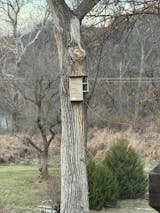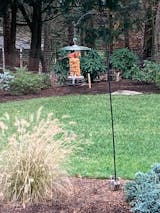How can it possibly be late September already? The days are getting increasingly shorter and there is that distinctive nip in the air when you venture outdoors first thing in the morning. I am definitely a warm-weather sort of person, but I do enjoy experiencing all 4 seasons here in Southern Indiana. Well...as long as winter only lasts about 3-4 weeks...or less. But as much as I dislike the colder weather, I do enjoy what these seasonal changes bring to the bird world. A changing of the guard, so to speak. Some of our favorites stick with us year round; and while I hate to see a few of the others go, it's exciting to see their replacement teams fly in to take their place in the yard. I'd like to dive into Fall Migration with you for a bit and discuss some of the changes we are already beginning to see.
First of all, not all migrations are created equal. The ole "birds fly north in the summer and back south in the winter" is a fairly true statement, but it's a lot more complicated than that. Fall Migration is a BIGGER deal than Spring Migration in terms of size and length of time. Think about what birds are doing during Spring Migration. They are flying north to find suitable habitats in which to raise a family. So they are motivated! Gotta get there quick and find the best territory! Need to beat my cousins to the punch! GO, GO, GO! They come here in the spring because of the natural resources we have to offer during that time of year - lots of plants, insects and nesting locations. Fall Migration, on the other hand, is a bit more drug out and not quite as hurried; not to mention it involves a lot more birds! Why is that? All the new kids are now in the mix! Fall Migration in the Northern Hemisphere begins in mid-September and stretches all the way through the end of November.
Evansville Courier and Press - 09/25/2022
So what exactly drives migration? For the birds that do migrate it is simply instinctual. Hard-wired into their tiny brains is a genetic code that tells them when to leave and where to go. If you research the migration phenomenon, you will find that no one seems to have an exact answer as to how all of the pieces appear to fall into place so easily. How do they know when to go? There are a few things scientists seem to have determined at this point. There are several environmental factors that help drive this instinct. A common misconception is that birds know when to migrate when it starts to get colder. Not exactly... Length of day is the driving factor. When daylight starts to fade and the days become shorter, the need to leave kicks in. This is not to say that weather doesn't play a role in the process. Birds are smart. When a cold front moves through with stronger northerly winds, this will send a lot of them packing. Having that tailwind to help push them along is a huge help - and they will take advantage of it. Yet another factor that comes into play is the food source. Those same birds that arrived in the spring to sip our nectar and eat our bugs are now finding a lack of both. Time to go someplace else so we don't starve! So while length of day is the biggest influencer, weather and food resources also play an important role.
That was the when, but what about the where? This is probably the most amazing part of migration that scientists have a hard time explaining. The bottom line is it has to be inherently instinctual. A genetic imprint on their brain tells them where to go. A few theories point to the sun's location, star positions, smells or landmarks. It is thought that birds use every sense available to them to navigate their way back home in the fall. There have been many studies done and scientists have been able to establish 4 distinctive "flyways", or migration routes in the US. Here in Southern Indiana we're in the middle of the Mississippi Flyway which sports the largest numbers of bird movements. The Mississippi Flyway is home to 40% of the US shore bird migrators, as well as sparrows, thrushes, warblers (too many species to list), bobolinks, Eastern Meadowlarks and more. Our US Flyways are migration routes to about 4 billion birds. Yes - BILLION! In fact, according to BirdCast, they estimated 228M migrating birds flying overhead in the night sky on September 15 of this year. Most of these birds are traveling to southern points in the US, Mexico, the Caribbean, Central America and even as far as the northern parts of South America. And they are accomplishing this trip at night, mostly alone. Some will launch themselves in a dangerous journey directly over the Gulf of Mexico from south Florida. Others will fly down the eastern Texas coastline, staying closer to the safety of land, but lengthening their journey. Unfortunately some of them don't make it; but thankfully, most of them will. Imagine taking off on an 18-hour journey over the Gulf of Mexico without a weather app or radar to tell you what lies ahead?

Now let's talk for a minute about some specific bird species. Who migrates and who doesn't? This varies a bit across the US, so I am going to talk mostly about the Midwest, since that is familiar to me. 80% of North American birds migrate; some a short distance, others a much longer distance. An estimated 350 species are considered "long distance migrators". This list includes our beloved Ruby-Throated Hummingbirds, Indigo Buntings, Rose-Breasted Grosbeaks, Purple Martins and more. There are also many, many shorebirds in this group, but one in particular wins the prize for longest distance traveled. The Arctic Tern migrates over 44,000 miles from its northern breeding grounds in the Arctic to winter in Antarctica. Not many can compete with that! The Killdeer is an example of a medium-distance migrator, while the short-distance group includes Red-Winged Blackbirds, Cedar Waxwings and the American Tree Sparrow. Lastly, at least in this neck of the woods, our permanent, year-round residents include the Northern Cardinal, Blue Jay, Eastern Bluebird, Northern Mockingbird, House Finch and American Goldfinch. Some birds on this list may surprise a few locals. A lot of people assume certain birds migrate because they no longer see them in the winter months. This isn't always true. Some birds will seek winter shelter and safety in the woods, away from populated areas. In my experience, our #1 mislabeled, non-migrating species is the American Goldfinch. Many people think they leave in the fall. They do not. These beautiful little yellow birds are with us year round; however, not always are they so yellow. Goldfinch are the only North American songbird to molt twice every year. Right now they are molting for a second time, shedding those bright yellow feathers and replacing them with drab, brownish-green plumage. So they're still with us, just not nearly as noticeable.

After many of our summer birds have left us, they are replaced with the winter birds from places north. Two of our most common (and really cool!) winter birds are Dark-Eyed Juncos and White-Throated Sparrows. I think my mom still to this day refers to the Junco as a "Snowbird". They, like the White-Throated Sparrows, are expert foragers. You will see them on the ground, especially under bird feeders, foraging for seeds. The White-Throated Sparrow will be more apt to visit the feeder itself, while the Junco will hang out on the ground underneath. I find that offering sunflower hearts in tray feeders will really attract these awesome little birds.

Migration is tough! What can we do to help our feathered friends during Fall Migration and into the winter months ahead? I'd like to share a few helpful tips.
1) During Fall Migration, mid-September through December 1, try to leave bright, outdoor lights off during the night. City lights and clusters of bright lights can negatively impact birds' abilities to properly navigate.
2) Offer a water source in your yard. While bubbling or moving water is best, any type of water offering can be very helpful to those migrators that might stop off in your yard to take a break from their journey. Please remember to never add glycerin to your outdoor water. While this might keep it from freezing, it could also harm the birds. If you plan to leave water out in the cold winter months (which is a good thing!) please use a quality, electric bird bath heater/deicer.
3) For our arriving winter birds, help them by creating a bird friendly environment. Not only is water important, but having native plants in your yard is a big help too. These plants will sustain an insect population in the warm months and a lot of them will produce berries during the cooler months. They also offer the birds a place to seek shelter in and around them.
4) Refrain from clearing out your dead, "end-of-season" plants in the landscaping. Avoid dead-heading. Try to refrain from cleaning up all the fallen leaves in your yard. Maybe leave a few around the edges or in your landscaping through the winter. All of these things will provide good shelter and foraging areas.
5) If you have trees, then you likely will have some limbs falling off occasionally. Instead of burning them or throwing them in the trash, consider making a branch pile in a corner of your yard and leaving it there until spring. We have a 10'X5' raised bed in our backyard. After the plants die off in the late fall, I will pull them and turn the garden bed into a stick pile. "Tepee" the sticks, leave them loose and not so densely packed. This will give the birds a spot to seek shelter and security. Don't worry, they won't be building nests there in the winter months!
I hope this has provided you with some insight into the fascinating world of bird migration. When you sit back and really think about the feats these small creatures achieve twice a year, it is truly amazing! Check back with us in the spring when we are sure to discuss the flipside, Spring Migration.



